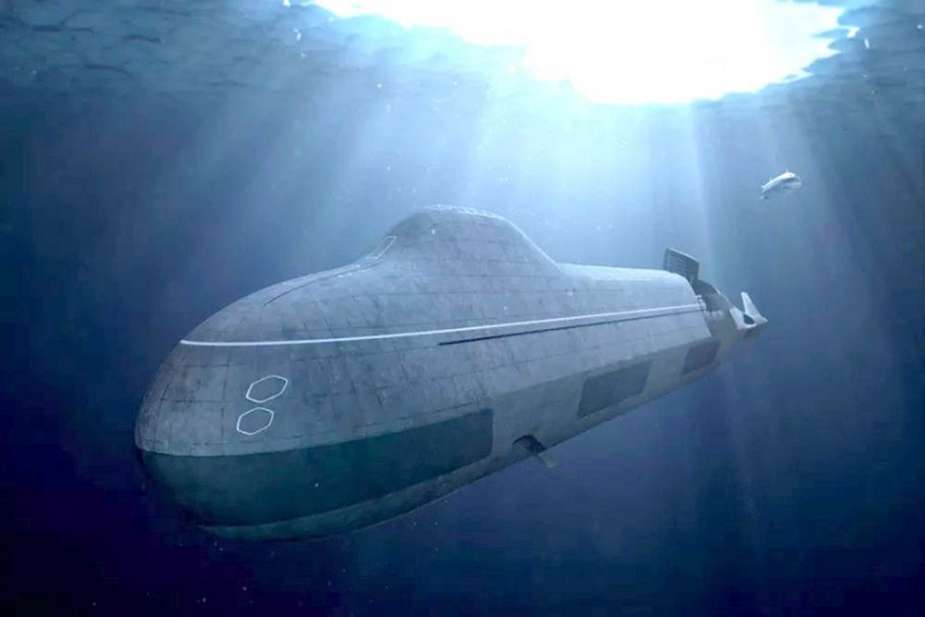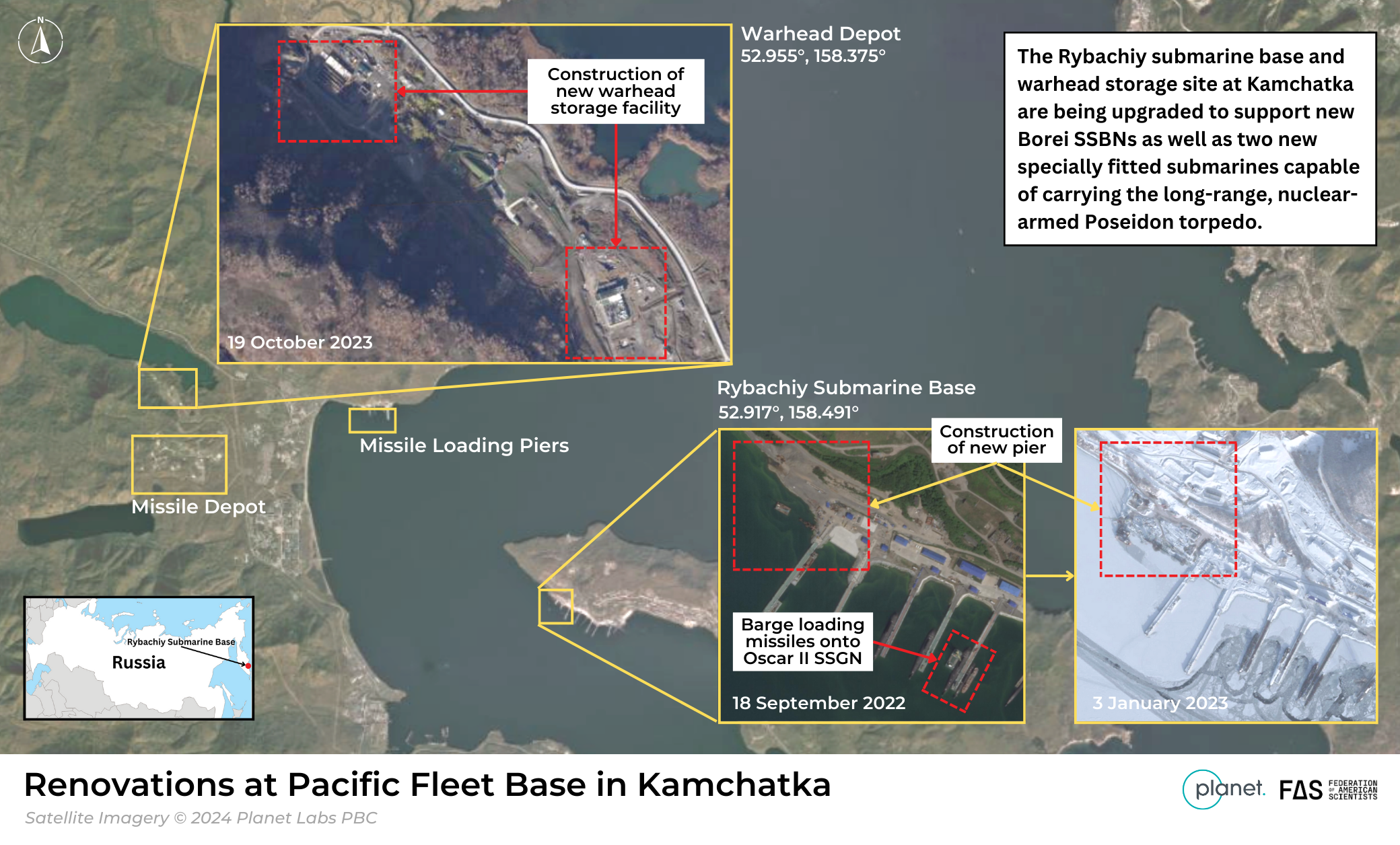 |
| The Arcturus class, presented in 2022, was intended as the next generation of Russian ballistic missile submarines (SSBNs), aiming to replace the existing Borei class by 2037 (Picture source: Rubin) |
Russia has unveiled its advanced concept for what it touts as a super stealthy Ballistic Missile Submarine (SSBN). The new submarine is named ‘Arktur’‘ or ‘Arcturus’ after the brightest star in the northern celestial hemisphere, as per state media. Russian submarine design bureau Rubin stated that the Arctic will be the Arcturus’ primary area of operations.
Russia Developing Fifth Generation Nuclear-Powered Submarine
The general director of the Central Design Bureau of naval equipment, Igor Vilnit, stated that Russia is developing a fifth-generation nuclear-powered strategic missile submarine, and specialists from the Central Design Bureau "Rubin" are doing this. "We have started work on a fifth-generation strategic submarine," Vilnit said on the sidelines of an expanded meeting of the Academic Council of the Krylov State Scientific Center.
He noted that the new missile carrier will be better than the missile carrier "Arctor". The concept of the "Arctor" missile carrier was first presented at the "Armia-2022" forum, it was planned that it would be equipped with a set of hydroacoustic and radar equipment, marching submarines, the submarine could perform auxiliary and combat missions, and it is also capable of carrying 12 intercontinental ballistic missiles.
Russia starts development of 5th-generation strategic submarine set to surpass Arcturus-class
Vilnit also discussed the collaboration between the Central Design Bureau and the Krylov State Research Center, stressing the importance of transitioning from past projects to future plans. He pointed out the ongoing construction of serial ships and emphasized the necessity of initiating new projects promptly to keep pace with technological advancements in naval warfare.
He urged engagement in new projects to address emerging challenges, aiming to ensure that the submarine fleet remains a significant component of national defense. Vilnit's remarks suggest a focus on maintaining technological advancement to address potential threats.
The Arcturus class, presented by the Rubin Design Bureau at the Army-2022 exhibition, was intended as the next generation of Russian ballistic missile submarines (SSBNs), aiming to replace the existing Borei class by 2037. This model introduces an angled outer hull intended to reduce the sonar signature, a feature that aligns with contemporary submarine stealth technologies, including the application of anechoic coatings and vibration-isolating measures for machinery. The design indicates a 20% decrease in displacement compared to current models, plans for a crew complement of around 100, and a length of 134 meters. It is designed to carry 12 nuclear-armed intercontinental ballistic missiles, tailored for operations in Arctic conditions, reflecting a strategic move towards fewer but more advanced missiles.
The Arcturus class incorporates new elements such as the Surrogat-V autonomous underwater vehicle (AUV), designed for anti-submarine warfare, equipped with a sonar array, and a non-acoustic detection system known as SOKS, aimed at tracking submarines through chemical and radiation trails. The inclusion of AUVs indicates an expansion of the submarine's operational roles beyond traditional missile delivery. The design features a compartment for AUV launch and retrieval, suggesting an emphasis on versatility and reconnaissance capabilities within its strategic framework.
The Arcturus submarine is planned to incorporate a nuclear power plant, distinguishing it from traditional designs, as it is proposed to use a shaftless power system to potentially lower noise levels, a crucial aspect for submarines aimed at stealth, similar to the German Type-212CD and the British Dreadnought-class submarines. The propulsion system is intended to use two stern water jets housed within the submarine's structure. These jets, operated by drawing in water through openings on the sides and expelling it through rectangular nozzles, are designed with trapezoidal vertical planes to potentially enhance noise reduction efforts.
Despite the advanced features presented in the Arcturus class design, its construction prospects are uncertain, largely due to Russia's current economic conditions and historical delays in submarine production. The Rubin Design Bureau's design remains a proposal without official project sanctioning, reflecting potential trends in Russian naval design but not necessarily translating into immediate construction plans. Yet, the statements by Vilnit imply that the fifth-generation submarine project aims to surpass the initially outlined capabilities and specifications of the Arcturus class. Despite the lack of detailed information, this indicates an evolution in the strategic approach to Russia's submarine development programs to keep a leading position in terms of naval warfare.
Upgrades to Russia’s Nuclear-Capable Submarine Fleet - Federation of American Scientists

02.07.24 | 6 min read | Text by Eliana Johns
[With updated graphic] Russia is in the midst of a decades-long nuclear force modernization program intended to replace Soviet-era missiles, aircraft, and submarines with new systems. As part of this project, Russia’s Navy is currently modernizing its nuclear-powered ballistic missile submarine (SSBN) fleet and building new nuclear-powered guided missile submarines (SSGNs), along with other non-strategic nuclear-capable naval systems. The final delivery of these new strategic and non-strategic submarines to the Northern and Pacific fleets is expected to be complete by the early 2030s. FAS has tracked the progress of these developments as well as the upgrades to the supporting naval infrastructure, including submarine piers, missile loading piers, and new nuclear warhead storage facilities.
Putin commissions new nuclear-capable submarines
On 11 December 2023, Russian President Vladimir Putin traveled to the Sevmash shipyard in Severodvinsk to attend the flag-raising ceremony for two new nuclear-capable submarines. Putin’s trip to Severodvinsk came days after he declared his intention to seek another six-year presidential term.
At the shipyard, Putin oversaw the raising of the Russian Navy’s flag on the newly completed Borei-A Emperor Alexander III (K-554) SSBN and the Yasen-M Krasnoyarsk (K-571) SSGN. Putin also visited the Admiral Kasatonov frigate of Russia’s Northern Fleet, which was recently modernized to carry four Zircon hypersonic cruise missiles. A Maxar Technologies satellite captured preparations for the ceremony at Sevmash three days before Putin’s arrival.

Newly commissioned submarines at Sevmash Shipyard, Severodvinsk, Russia
On December 11, 2023, President Vladimir Putin visited the Sevmash shipyard in Severodvinsk, Russia, to oversee the flag-raising ceremony for the Emperor Alexander III Borei-A nuclear-armed ballistic missile submarine and the Krasnoyarsk nuclear-powered guided missile submarine before they begin their service as part of Russia’s Pacific Fleet. Putin also visited the Admiral Kasatonov frigate, which has been modernized to carry Zircon hypersonic cruise missiles.
Unlike many other nuclear–armed states, it is not unusual for Putin to oversee ceremonies or drills relating to Russia’s nuclear forces. He regularly attends flag-raising ceremonies of other nuclear-powered submarines and nuclear force exercises as a signal of strength and confidence in Russian nuclear capabilities. In fact, Kremlin Spokesman Dmitry Peskov stated before a February 2022 strategic deterrence force drill that “such drills and training launches, naturally, can’t be held without the head of state,” referring to Putin’s observance of the exercise.
 |
TOP LEFT: Putin views a strategic command post exercise in the Barents Sea in 2004. |
While it is common for Putin to observe Russian nuclear force exercises and activities, this practice is not as customary in other nuclear-armed states. Leaders of other states will occasionally attend ceremonies or military parades that feature nuclear-capable weapons as a sign of power, but aside from in North Korea, heads of state do not regularly oversee nuclear weapons testing, exercises, and other related activities in person. Putin’s practice of uniquely observing these nuclear force drills or the commissioning of strategic weapons is presumably intended to signal the centrality of Russia’s nuclear weapons in its military doctrine.
Russian submarine fleet modernization
Submarines play a key role in Russia’s deterrence strategy, given that their stealth and survivability provide an important second-strike capability. The recent commissioning of new nuclear-powered submarines into the Pacific Fleet is a part of a larger modernization campaign as Russia’s older submarines begin to reach the ends of their service lives.
The Russian Navy currently operates two classes of SSBNs: five Delta IV (Project 667BRDM Delfin) and eight Borei (Project 955/A), five of which are the improved Borei-A (Project 955A) variant. The Emperor Alexander III––the submarine that Putin observed in December––is the seventh Borei-class submarine to enter service and the fourth of the upgraded Borei-A type. The Emperor Alexander III will be based with the Pacific Fleet located in the Kamchatka Peninsula.
Two additional Borei-A SSBNs are currently under construction, and two more are thought to be in the planning stages. Eventually, it is expected that six Borei SSBNs will be assigned to the Northern Fleet based in the Kola Peninsula, and six will be assigned to the Pacific Fleet. The new generation of Borei SSBNs will replace the Soviet-era Delta IV submarines, which are scheduled to be decommissioned throughout the late-2020s and early-2030s.
Each Borei submarine is capable of carrying 16 Bulava (SS-N-32) submarine-launched ballistic missiles (SLBMs), which can carry up to six warheads each. However, it is likely that each missile has been downloaded to four warheads to comply with the New START limit on deployed strategic warheads. Although President Putin “suspended” Russia’s participation in New START in February 2023, Russian officials subsequently stated that Russia would continue to abide by the treaty’s central limits; if so, these SLBMs presumably still carry a reduced number of warheads. This limit falls away when the New START treaty expires in February 2026 unless it is replaced with a new agreement.
A possible next generation Russian strategic nuclear submarines concept – known as “Arktur” or “Arcturus” – was unveiled at the “Army 2022” International Military-Technical Forum and could potentially start replacing the Borei-class submarines sometime after 2037. Notably, an industry official said the Arktur-class will be smaller than the current Borei-class and have a reduced number of ballistic missiles. The design concept appears to allow the submarine to also carry other weapons as well as an unmanned underwater vehicle, which would imply a multi-mission role. New SSBN variants will also likely be equipped with reactor technology that extends the amount of time required between refueling, which will significantly shorten midlife maintenance operations and allow for more submarines to be on patrol at the same point in time.

In addition to strategic SSBNs, the Russian Navy operates sea-based nonstrategic nuclear weapons, including land-attack cruise missiles, anti-ship cruise missiles, torpedoes, and more, which can be launched from naval systems such as aircraft carriers, cruisers, frigates, corvettes, naval aircraft, and guided missile submarines such as the Krasnoyarsk––the other submarine that Putin observed in December.
The Russian Navy is also building submarines specially configured to carry a new nuclear-powered, long-range, nuclear-armed torpedo called Poseidon. The first of these submarines—Project 09852 Belgorod (K-329)—was delivered to the Russian Navy in July 2022 and reportedly will be capable of carrying up to six Poseidon torpedoes. The second submarine—Project 09851 Khabarovsk—is in the final stages of construction at the Sevmash Shipyard and will also reportedly carry up to six Poseidon torpedoes. One more specially configured submarine is planned to be delivered to the Russian Navy by 2027, for a total of at least three Poseidon-capable submarines.
Upgrades to Pacific Fleet infrastructure
A new division of specially configured submarines will reportedly be stationed with the Pacific fleet by the end of 2025. To support this expansion, as well as the additions of the Krasnoyarsk, Emperor Alexander III, and eventually more Borei submarines, infrastructure at the Pacific Fleet naval base in Kamchatka is undergoing significant renovations. In the past several years, Russia has added additional storage at the missile and warhead depots and begun construction of a new pier. These projects can be seen from satellite imagery captured by Planet Labs PBC.

Renovations at Pacific Fleets Base in Kamchatka
The Rybachiy submarine base and warhead storage site at Kamchatka are being upgraded to support new Borei SSBNs as well as two new specially fitted submarines capable of carrying the long-range, nuclear-armed Poseidon torpedo.
While upgrades to the existing warhead storage facilities at the Rybachiy submarine base in Kamchatka began sometime after August 2013, construction of a new underground warhead storage facility began in early 2020 and is ongoing. The existing storage facility was built to accommodate warheads for now-decommissioned Delta III submarines, but those missiles could only carry three warheads on each missile. Since the new Borei SSBNs will be able to carry up to six warheads on each of its 16 SLBMs, the new facilities are likely meant for the Pacific Fleet to accommodate additional warheads as Russia completes the modernization of the submarine fleet in the coming years.
This new storage addition is also particularly interesting because of its unique design – the facility has a different layout than existing Russian naval warhead storage facilities in the Pacific and Northern Fleets and seems to be designed similarly to what the U.S. Navy has built for its Pacific SSBN fleet.

Comparison of existing U.S. and new Russian naval warhead storage sites
Construction of a new underground warhead storage facility at Russia’s Rybachiy Submarine base began in early 2020. This new facility has a different layout and has a larger storage capacity than existing Russian naval warhead storage facilities. The new design is also similar to what the U.S. Navy has built for its Pacific SSBN fleet with rows of long storage bays connected to technical and administrative facilities that are accessible via vehicle access ramps.
This research was carried out with generous contributions from the New-Land Foundation, Ploughshares Fund, the Prospect Hill Foundation, Longview Philanthropy, and individual donors.
Russian submarine design bureau Rubin has unveiled its latest design for a ballistic missile submarine (SSBN) at the Army 2022 defense expo. The new boat, named ‘Arcturus’ (Арктур) after the brightest star in the northern celestial hemisphere, is a radical design.
Most striking about the design is that it has an angled outer hull with sloping sides and blended lines. It has a chine running all the way along the side, resembling a modern low-observable aircraft.
Submarines are, by their nature, stealthy. The Arcturus design takes this further than most however, adding an angled outer hull. This matches similar ideas in other countries for deflecting incoming active sonar. This is reminiscent of the German-designed Type-212CD which is being built for Germany and Norway. And the British Dreadnought Class ballistic missile submarine.
The angled outer hull, designed against active sonar, would be accompanied by traditional passive-sonar stealth. This involves mounting the machinery on rafts, to isolate sources of noise. There would also be anechoic coatings outside the pressure hull. Russian anechoic coatings are complex and are used extensively on their submarines.
The submarine has 12 missile silos. These are large enough for nuclear-armed ballistic missiles, which appears to be the primary mission. But one of the tubes is displayed with a launch and retrieval mechanism for a medium-sized AUV ( autonomous underwater vehicle). This implies a multi-role capability.
12 tubes is fewer than current SSBNs but other submarine builders are going in the same direction. As the missiles get more potent, the number required to ensure unacceptable losses for an enemy gets fewer. Additionally the missiles are incredibly expensive to manufacture and maintain.
Specialist Underwater Drone: Surrogat-V
A new feature, not seen on previous designs, is that two (possibly 3) specialist AUVs are carried. 3 large free-flooding hangars are seen at the stern for Surrogat-V (Суррогат-В) AUVs. These companion AUVs are designed to operate in conjunction with the Arcturus submarine.
Previous AUV designs for Rubin which use the Surrogat name have been designed as decoys and training devices. These are claimed to be able to replicate other submarine’s signatures.
However, Surrogat-V appears to be an anti-submarine warfare drone. It has a relatively large conformal sonar array, and a pump jet propulsor, suggesting high underwater speeds.
It is also equipped with SOKS (System Obnarujenia Kilvaternovo Sleda), a nonacoustic submarine detection system. This ‘sniffs’ chemicals and radiation left in the wake of a submarine to help trail it. Russia and Britain both deploy similar systems for this. The inclusion of SOKs implies that the AUV is intended for anti-submarine warfare.
Another new model on display was the E-Amur (Е-Амур) design. This is a very small submarine with no traditional sail and X-rudders. Flank sonar arrays are grafted onto the outside, implying single-hull construction, similar to existing Lada / Amur class designs. Four torpedo tubes are carried.
Outlook For The Arcturus Submarine
Rubin has a long tradition of building impressive submarines. They designed the Typhoon class, still the largest subs ever built. And the Borei Class, which is replacing all older ballistic missile submarines (SSBNs), is too. So it is not surprising that their design concepts are ambitious and represent cutting-edge thinking.
But the chances of Arcturus being built seem slim. The design is a company proposal rather than a sanctioned project, else it would have a project number. And the current Russian economic situation, and extensive delays in current submarine building, do not bode well for it.
But the design is interesting in its own right. And it shows the direction of thinking among Russian submarine designers. There may be hints of future designs which could actually make it into the water. Russia’s submarine designers will do their best to keep up with the West, on paper if not in steel.



No comments:
Post a Comment